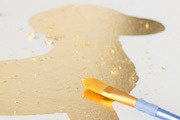Shawn Syse spends her free time coloring people's bodies. She's not using a needle like tattoo artists or even ink. Shawn uses a mixture of crushed dried henna leaves, lemon juice, eucalyptus oil and sometimes a strong dark tea or even coffee. Henna or mehndi is a temporary tattoo with a history that goes back thousands of years. Over 5000 years ago it was used on Egyptian mummies and as a healing medicine in the Middle East.
Shawn and her husband own Mehndi2DyeFor in Minneapolis, Minnesota. The 31 year-old has been a professional henna artist for about four years. At one time she wanted to get a tattoo and found out about henna instead. She became fascinated with the art and began practicing. First it was a hobby and now it's a profession. She did finally get her tattoo - a circle of suns and moons around her ankle.
Most of the couple's work is done at private parties, corporate events and festivals. At any number of festivals Frank and Shawn are up at 7am and off to set up at the festival grounds. "Working at festivals is a lot about educating the general public to the art of mehndi and exactly what it is, how it works, how long it lasts (about two weeks), what's in the paste, and so forth. We spend a good part of the day creating beautiful designs one after the other, many times hours without breaks."
"Typically we are most asked to henna hands, ankles, tops of feet (and soles too), ankles, wrists, lower backs, backs of necks, shoulders and backs. The strangest place I have ever hennaed was the middle of a guy's face, like where your third eye would be or where someone would wear a bindi (the red spot worn by Bramin Hindus,)" explains Shawn. She says the most common tattoo is a toss up between armbands and anklets.
Henna art is usually made from 100 percent natural ingredients and only comes in different shades of brown/mahogany/dark orange. "Any other colored hennas you see on the market today, including black henna, are actually not henna at all but some type of food coloring that will rub off and ruin clothing," warns Shawn. "Some black hennas, which are not henna at all, include toxic chemicals that can cause internal organ damage, burning, blistering and permanent scaring." Her advice is to stay away from black henna and have your designs done by a reputable artist, who you can contact if you have any type of reaction.
The artist doesn't plan on drawing on people for the rest of her life. She's going to culinary school to become a chef. As much as she likes henna the passion to cook is much stronger.
Do you have a favorite artist? Is there a type of art you really love?






























